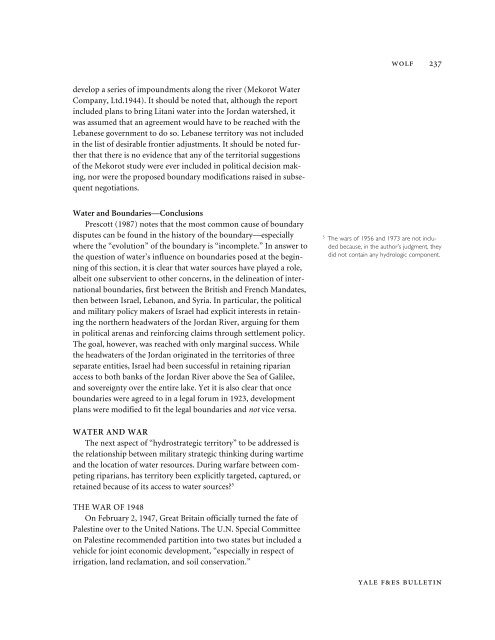Hydrostrategic Decisionmaking and the Arab ... - Yale University
Hydrostrategic Decisionmaking and the Arab ... - Yale University
Hydrostrategic Decisionmaking and the Arab ... - Yale University
You also want an ePaper? Increase the reach of your titles
YUMPU automatically turns print PDFs into web optimized ePapers that Google loves.
WOLF 237develop a series of impoundments along <strong>the</strong> river (Mekorot WaterCompany, Ltd.1944). It should be noted that, although <strong>the</strong> reportincluded plans to bring Litani water into <strong>the</strong> Jordan watershed, itwas assumed that an agreement would have to be reached with <strong>the</strong>Lebanese government to do so. Lebanese territory was not includedin <strong>the</strong> list of desirable frontier adjustments. It should be noted fur<strong>the</strong>rthat <strong>the</strong>re is no evidence that any of <strong>the</strong> territorial suggestionsof <strong>the</strong> Mekorot study were ever included in political decision making,nor were <strong>the</strong> proposed boundary modifications raised in subsequentnegotiations.Water <strong>and</strong> Boundaries—ConclusionsPrescott (1987) notes that <strong>the</strong> most common cause of boundarydisputes can be found in <strong>the</strong> history of <strong>the</strong> boundary—especiallywhere <strong>the</strong> “evolution” of <strong>the</strong> boundary is “incomplete.” In answer to<strong>the</strong> question of water’s influence on boundaries posed at <strong>the</strong> beginningof this section, it is clear that water sources have played a role,albeit one subservient to o<strong>the</strong>r concerns, in <strong>the</strong> delineation of internationalboundaries, first between <strong>the</strong> British <strong>and</strong> French M<strong>and</strong>ates,<strong>the</strong>n between Israel, Lebanon, <strong>and</strong> Syria. In particular, <strong>the</strong> political<strong>and</strong> military policy makers of Israel had explicit interests in retaining<strong>the</strong> nor<strong>the</strong>rn headwaters of <strong>the</strong> Jordan River, arguing for <strong>the</strong>min political arenas <strong>and</strong> reinforcing claims through settlement policy.The goal, however, was reached with only marginal success. While<strong>the</strong> headwaters of <strong>the</strong> Jordan originated in <strong>the</strong> territories of threeseparate entities, Israel had been successful in retaining riparianaccess to both banks of <strong>the</strong> Jordan River above <strong>the</strong> Sea of Galilee,<strong>and</strong> sovereignty over <strong>the</strong> entire lake. Yet it is also clear that onceboundaries were agreed to in a legal forum in 1923, developmentplans were modified to fit <strong>the</strong> legal boundaries <strong>and</strong> not vice versa.5The wars of 1956 <strong>and</strong> 1973 are not includedbecause, in <strong>the</strong> author’s judgment, <strong>the</strong>ydid not contain any hydrologic component.WATER AND WARThe next aspect of “hydrostrategic territory” to be addressed is<strong>the</strong> relationship between military strategic thinking during wartime<strong>and</strong> <strong>the</strong> location of water resources. During warfare between competingriparians, has territory been explicitly targeted, captured, orretained because of its access to water sources? 5THE WAR OF 1948On February 2, 1947, Great Britain officially turned <strong>the</strong> fate ofPalestine over to <strong>the</strong> United Nations. The U.N. Special Committeeon Palestine recommended partition into two states but included avehicle for joint economic development, “especially in respect ofirrigation, l<strong>and</strong> reclamation, <strong>and</strong> soil conservation.”YALE F&ES BULLETIN
















